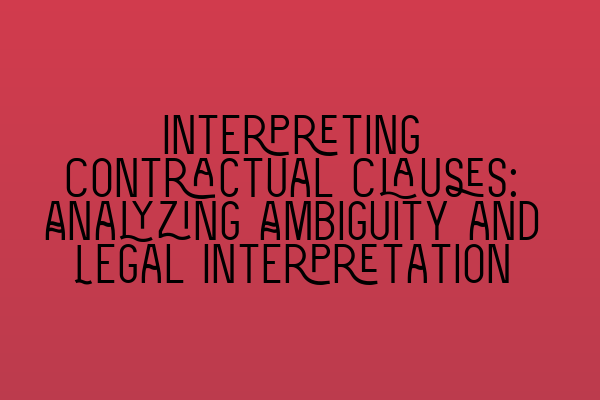Interpreting Contractual Clauses: Analyzing Ambiguity and Legal Interpretation
When it comes to contract law, one of the essential aspects of drafting and interpreting contracts is analyzing and understanding contractual clauses. These clauses outline the rights and obligations of the parties involved and serve as the foundation for the entire contractual relationship. However, contractual clauses can sometimes be ambiguous, leading to confusion, disputes, and potential legal issues. In this article, we will delve into the intricacies of interpreting contractual clauses, specifically focusing on ambiguity and legal interpretation.
What is Ambiguity?
Ambiguity in contractual clauses refers to situations where the language used is unclear or open to more than one interpretation. It can arise due to poorly drafted clauses, conflicting provisions, or the use of technical or industry-specific terms that are not well-defined. Ambiguity can be either latent or patent. Latent ambiguity exists when the language appears clear on its face but becomes ambiguous when applied to the actual circumstances. On the other hand, patent ambiguity is evident from the language itself and leaves room for multiple interpretations.
Analyzing Ambiguity
When faced with an ambiguous contractual clause, it is crucial to analyze the context, purpose, and intentions of the parties involved to determine the most reasonable interpretation. Courts typically follow specific methods and principles to interpret contractual clauses, such as the plain meaning rule, the contra proferentem rule, and the objective approach.
The Plain Meaning Rule
The plain meaning rule suggests that when a contractual clause is clear and unambiguous, it should be interpreted according to its ordinary and natural meaning. In other words, the court will give effect to the plain and obvious intention of the parties as expressed in the wording of the clause. This principle often takes precedence unless doing so would lead to an absurd or unreasonable outcome.
However, what happens when the clause is ambiguous or susceptible to multiple interpretations? In such cases, the court may resort to other methods of interpretation.
The Contra Proferentem Rule
The contra proferentem rule comes into play when a contractual clause is unclear and capable of more than one interpretation. This rule dictates that any ambiguity should be resolved against the party who drafted the contract or provided the ambiguous clause. The rationale behind this rule is that the party responsible for the ambiguity should bear the consequences of any resulting uncertainty.
This rule serves as a safeguard to protect the party who did not draft the contract from potential unfair terms or unexpected outcomes. It encourages the party drafting the contract to ensure clarity and precision in their language.
The Objective Approach
The objective approach, also known as the business efficacy approach or the reasonable person test, focuses on determining the intentions of the parties objectively. Under this approach, the court considers the language used in the contractual clause, the surrounding circumstances at the time of contracting, and the purpose of the contract. The goal is to reach a commercially sensible and fair result that reflects the reasonable expectations of the parties when entering into the contract.
Legal Interpretation
Legal interpretation plays a crucial role in understanding and applying contractual clauses. When interpreting a contractual clause, it is essential to consider the specific legal principles and rules that govern contract law. Understanding these principles can help ensure that contractual clauses are interpreted accurately and consistently.
As a solicitor or legal professional, it is your responsibility to stay updated with the latest legal developments and precedent cases that may influence the interpretation of contractual clauses. Ongoing professional development and continuous learning can significantly enhance your ability to analyze and interpret contractual provisions effectively.
Conclusion
Interpreting contractual clauses is a nuanced and complex process. Ambiguity in contractual language can give rise to disputes, and legal principles such as the plain meaning rule, the contra proferentem rule, and the objective approach aid in resolving interpretative difficulties. By understanding the intricacies of contractual interpretation and staying informed about legal developments, solicitors can effectively analyze and interpret contractual clauses to protect the rights and interests of their clients.
Remember, effective interpretation requires a comprehensive understanding of contract law, as well as practical experience in applying legal principles to real-world scenarios. By continuously honing your skills, staying informed about the latest legal developments, and seeking professional guidance when needed, you can become a proficient and successful contract law expert.
Related Articles:
– SQE 1 Practice Exam Questions
– SQE 1 Practice Mocks FLK1 FLK2
– SQE 2 Preparation Courses
– SQE 1 Preparation Courses
– SRA SQE Exam Dates
